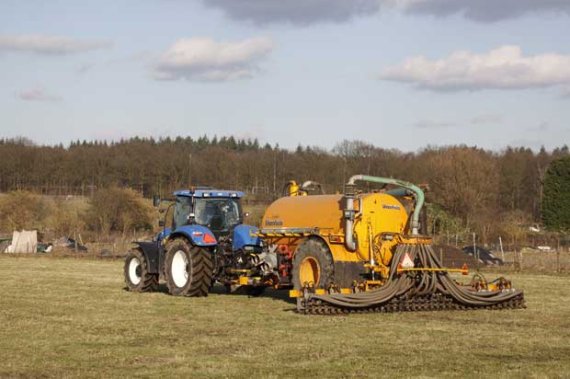Animal dung is full of nitrogen, which is converted into the volatile compound ammonia in the stalls and fields. That is why the government made low-emission application methods compulsory 15 years ago. The muck spreader squirting slurry in an arc over the field became a thing of the past. It was replaced by methods that injected the manure directly onto or into the soil. Ammonia emissions have fallen considerably since then. The sooner the manure is incorporated in the soil, the lower the ammonia emissions. Despite this, doubts have arisen concerning the strict ammonia guidelines in the Netherlands. A number of farmers oppose the injection of manure, in part because they question the calculations used in the model the guidelines are based on. These doubts have attracted the attention of the farming press, as became clear last week when a Wageningen MSc study received wide press coverage in farming journals and the Telegraaf newspaper. The study suggested that the Dutch model used to calculate ammonia emissions overestimates the emissions from surface spreading. One of farming researcher Egbert Lantinga’s students concluded that ammonia emissions could be a factor five less if the farmer sprays the manure with water after spreading it on the field. The student based this on ammonia measurements on one farm.
Surface spreading
But that does not mean the question has been settled. Last year, a working group of scientists from Wageningen UR, RIVM and NMI came to the conclusion that, on the contrary, a lot of ammonia is released through surface spreading. A field experiment with 50 farmers was intended to throw light on whether application measures and favourable weather conditions reduce ammonia emissions. No, or at least not significantly, concluded Jan Huijsmans from Plant Research International, who was involved in the project. However, that project too can be questioned, given that it used a model (albeit one based on measurements) rather than direct measurements of ammonia on the farms. ‘We wanted to do that but the ministry said it wasn’t necessary,’ says Lantinga. Emission measurements are expensive and two years ago the Ministry of Agriculture did not have the money or the interest.
Emissions are lower now
This gives rise to the question of whether the Dutch ammonia model gives a good estimate of actual emissions. Lantinga’s student research project does not resolve the issue because the method used is not appropriate for measuring the level of ammonia emissions, says Huijsmans. But Lantinga also points to Swiss research comparing the results of a number of ammonia studies. It showed that emissions from surface manure spreading were lower in recent studies than in similar research carried out in the 1990s. The reason for this difference is not clear. The Swiss study compared a number of measurements in various countries using different methods. It is not clear whether the differences are due to environmental conditions or the measurement method used.
New measurements
It is time to find out what is causing the conflicting findings, says Alterra’s Gerard Velthof. He is the secretary of the working group involved in the annual calculation of ammonia emissions in the Netherlands. He says it is clear that ammonia emissions vary considerably as a result of wind and rain and that ammonia behaves erratically in the field. Velthof feels it would be good if we could exclude the environmental factors so that we are purely comparing measurement methods. Therefore Wageningen UR will be submitting a research proposal for this to the Ministry of Economic Affairs. That project is likely to go through as there are already people in the farming press calling for a review of the manure policy now there is a possibility that ammonia emissions are being overestimated. The ministry has opted for manure injection to minimize ammonia emissions but there must be incontrovertible evidence that the calculations are correct if this policy is to have broad support. For this reason, the ministry cannot really avoid commissioning new measurements.

